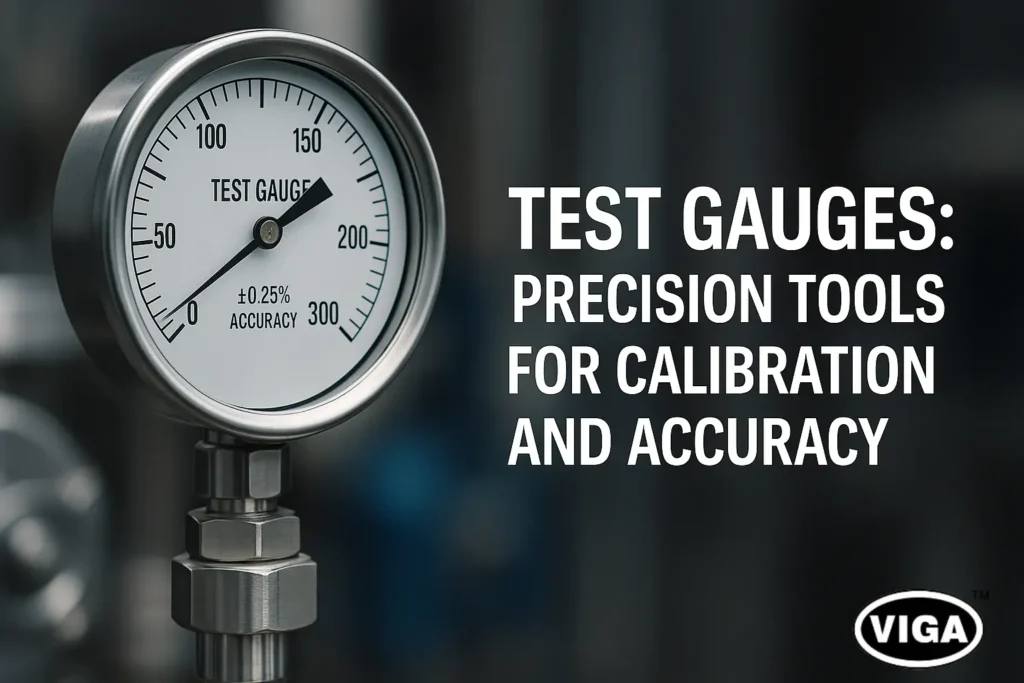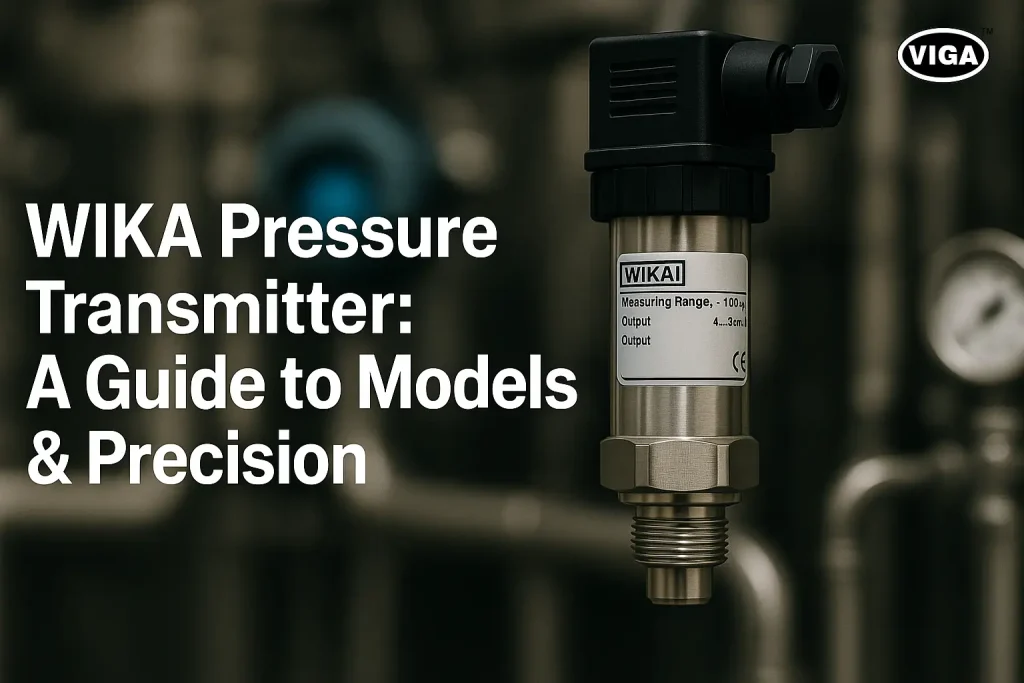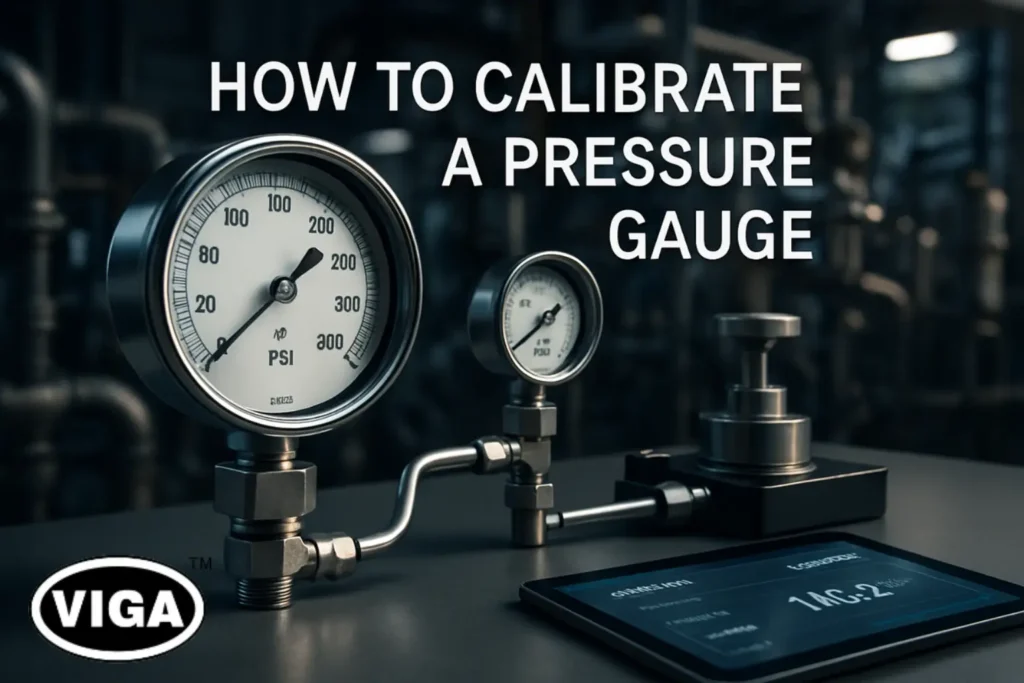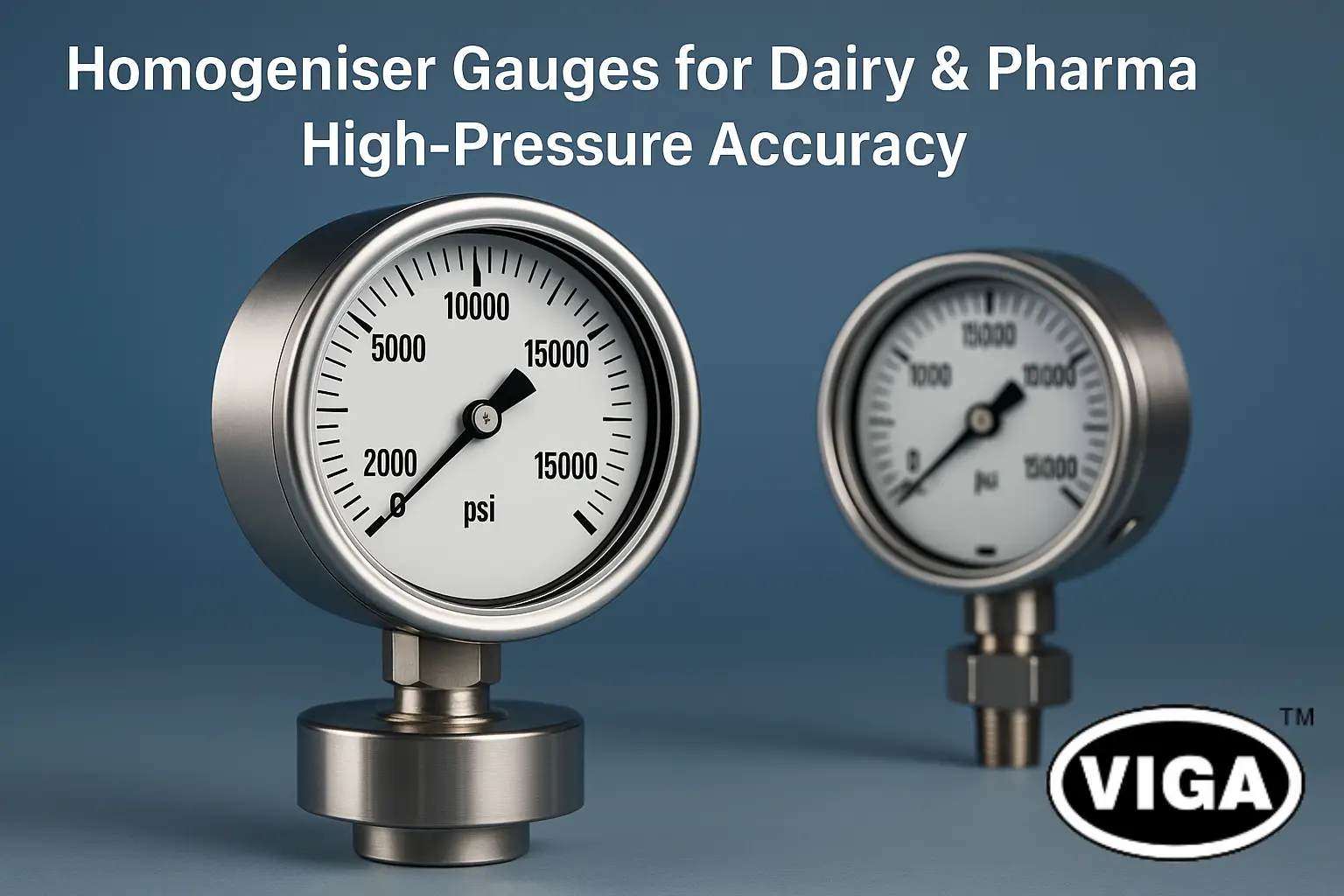
Homogeniser Gauges for Dairy & Pharma | High-Pressure Accuracy
Homogeniser Gauges in Dairy & Pharma: Ensuring Accuracy Under High Pressure
The delicate homogenization of milk and cream in dairy processing plants and the preparation of pharmaceuticals and other critical liquid medicaments in sterile pharmaceutical laboratories rely on and are a product of homogenization pressure processing. In turn, homogenization pressure processing is a sophisticated, intensive high-pressure transformation.
Thus, the milk in our cereal and the life-saving medication on a critical day comes down to the operational performance of the homogeniser gauge. It is the silent sentinel of the gauge, enforcing the pressure vigilant to the demanding metrics of high power, the transcendental quality of every product.
To achieve homogenization, it is necessary to force liquid through a very narrow gap, where it is subject to tremendous pressure and partitioning that, in turn, creates a stable emulsion. The pressure applied is enormous and can run up to thousands of pounds per square inch (PSI).
In the proportional absence of a monitoring and controlling method that is both accurate and reliable, the homogenization process would face the possibility of product failure, equipment compromise, and safety concerns.
In these circumstances, homogeniser pressure gauges (HPGs) serve functions that add value to the situation, and the feedback obtained is instrumental to control and consistency of homogenization in systems where precision is paramount.
Homogeniser Gauges: The Unsung Saviors
On a more fundamental note, a homogeniser gauge is a type of homogeniser instrument that is different from the rest in that it is designed to withstand the very unique and extreme conditions posed by a homogeniser.
Most homogenise gauges are made to withstand extreme pressures, but these are different in that they are made to survive extreme vibration and high levels of pulsating pressure that is accompanied by high levels of hygiene usually needed in the pharmaceutical and dairy industries.
What is the purpose of a Homogeniser Pressure Gauge? A Homogeniser Pressure Gauge is designed to indicate and measure the amount of pressure used on a fluid while homogenization is in progress.
In order to accomplish this in a clean manner, these gauges are almost always in association with a diaphragm seal. A diaphragm seal is used to protect and separate the internal workings of a gauge from the process media, such as milk, liquid drugs, and other formulations.
The pressure goes through the diaphragm into a fillable gauge, then to a filling fluid, which then moves the gauge’s pressure sensing mechanism, which is usually a Bourdon tube, The diaphragm and gauge design is crucial as it prevents the process fluid from getting into the gauge and eliminates the contamination.
In addition, these gauges are designed and build to endure the constant and severe pulsations of the homogenizer’s pump, a distinctive mechanism that averts the premature failure of these type gauges.
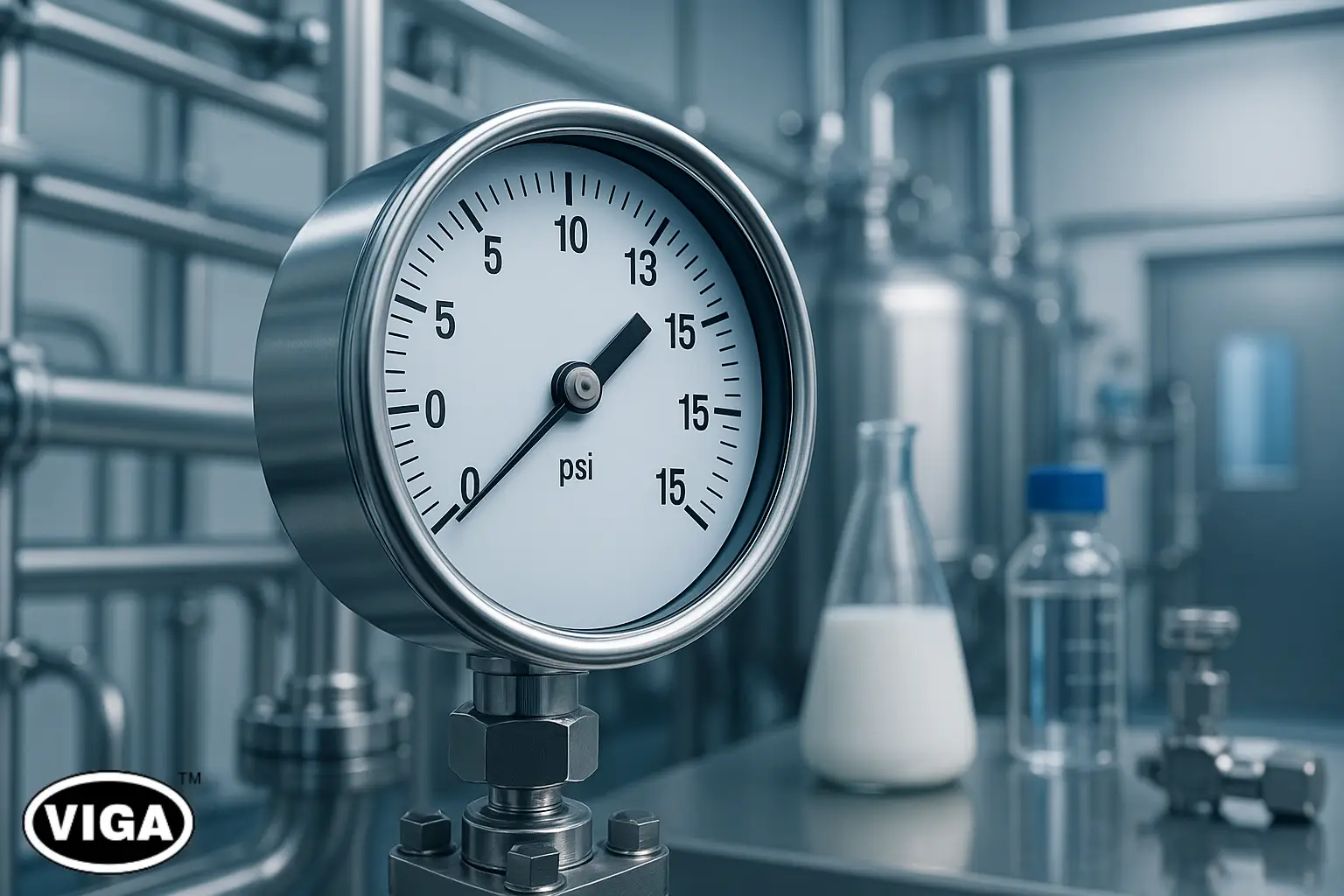
The importance of the Gauge of the High-Pressure Homogenizer.
The method of homogenization is critically dependent on the pressure used. The pressure applied is critical when breaking down the fat globules in milk or grinding active pharmaceutical ingredients (APIs) into micro sized particles required for stable product formulation. High pressure in these cases is a necessity. The High Pressure Homogeniser Gauges are constructed for these specific workloads.
They can gauge pressures exceeding 1,600 bar (or 15,000 psi) in a number of demanding operating conditions, and in some cases, even higher with phenomenal accuracy. These instruments are constructed with extraordinary engineering durability.
These factors include the robust parts of the equipment, for instance the diaphragm and process connection parts requiring minimal maintenance and engineered corrosion resistant. These parts are constructed for extreme pressure and extremely small gaps are used in the designs for maximizing accurate pressure readings. The outer casing is engineered with stainless steel 304 for durability and corrosion resistant for the elements.
The importance of Purity and Safety: Benefits of Gauge Sanitary Homogeniser.
Hygiene is a critical aspect of food and pharmaceutical manufacturing activities. It is for this reason that Sanitary Homogeniser Gauges have been developed. “Sanitary” or “Hygienic” means design of the instrument does not have features like: joins, threads, and spaces which products can hide, and bacteria can multiply.
The mirror polished product contact surfaces can be cleaned easily, either manually or through CIP (clean-in-place) systems, because of the absence of ports and dead ends in the system.
The apex of the sanitary design is the diaphragm seal which guarantees the safety of the delicate mechanics of the gauge while also avoiding any contamination.
The whole assembly is compliant with the stringent of industry regulations like the 3-A Sanitary Standards in the U.S which certify that the equipment is designed and fabricated for easy cleaning and effective inspection.
The positive consequences of investing in a high quality and durable gauge homogeniser is felt in various aspects ranging from the product, and operational safety.
Enhanced Product Quality and Consistency
In most cases, the more delicate the process, the more difficult and complicated it becomes, and in the case of dairy, the delicate process which border directly with the complicated, and with the most effort and care, maintain the size of each and every fat globule in homogenous milk to the size of a small pinhead.
This practice, of course, enables the eater the most efficient and stable experience. quivalently, in the case of pharma products, each granule of the tablet, relative to the correct bioavailability and dosage needed, must also be homogeneous for effectiveness insufficiency.
Operational Productivity and Improvement
In the scenario of apparatus, equipment, and other valuable partially finished and finished products, the equipment of, with, and undergoing over pressurization is regulated and controlled with much more certainty, which ultimately helps the people working with it.
Rather, it helps them avoid and escape dangerous situations which could put them in a perilous position. Besides, the people working the equipment in the situation of the pour for Liquid with other homogeneous liquid, the people working the equipment which the pour for Liquid happens, it is pourerably much more efficient and effective with an improvement of over 70% as it helps them work in a situation which much less waste of energy and product loss.
Shelf Life and Extensibility
In the case of emulsion which homogeneous without much effort spent, the ratio in between the two liquids is much more liquid than in the emulsion. In relative practice and application to, for instance, milk, with and without the emulsion, the waste and loss, in the direct relation practice scenario between income loss, profit, money, and revenue which expense expenditures, bounds much gain and higher profit.
Last and most certainly the, in the relative case of three high in value and profitable products which, in the case of emulsion spilt and waste, and in the ratio of gain and profit with the other emulsions, the value becomes multiplied and thereby more profit as more value is gained relative to the three emulsions.
Durability and Longevity Increase
These high value monetarily, with three products used in the case of emulsion, the dilution and ratio of the value gained becomes multiplied and thereby high profit. As for loss spilt and waste, in case, the ratio bounds also be gained and relative to much density value, the profit is relative multiplied higher and much easier to gain.
Core Applications: Homogeniser Gauges in the Dairy Industry
The dairy industry relies heavily on the homogenization process for the quality of a variety of products. Homogeniser gauges in the dairy industry are key for process control.
Milk: Most common is the application in the processing of milk which aims to eliminate the formation of a cream line by reducing globule membranes. This yields a more visually appealing, whiter, richer, and uniformly textured product. The gauge ensures the pressure which is normally between 100 to 250 bar (1500 to 3600 psi) is precisely maintained.
Yogurt and Ice Cream: In these products, correct homogenization is critical for a smooth, creamy texture and the prevention of fat separation, which results in a grainy or overly icy product.
Cream and Butter: Homogenization the control of the viscosity and stability of creams and improves the texture and shelf life of butter-based products.
The applications of Homogeniser Gauges in the Pharma Industry are similarly critical, but with far more focus on precision and sterility to protect the patients and ensure the effectiveness of the drugs.
Emulsions and Suspensions: Slims and syrups are some of the products which implements homogenizers to make certain that the Active Pharmaceutical Ingredian (API) within the products are fully dispersed. This helps to make sure that you will get the same amount of dose every time you use the product or swallow.
Biotechnology and Cell Disruption: The discharge of the contents of cells which are proteins and certain enzymes are captured due to the incorporation of homogenizers. Certain pressure ranges must be kept to ensure that the cells remain intact and the precious bits inside the cells are not harmed.
Vaccines and Injectables: The production of sterile injectables also incorporates the use of homogenizers to form stable nanoemulsions. This poises enhanced delivery and bioavailability of the drugs. The utmost importance is placed on the dial of the gauge which is used to measure and create particles of the exact required size for a proper functioning formulation.
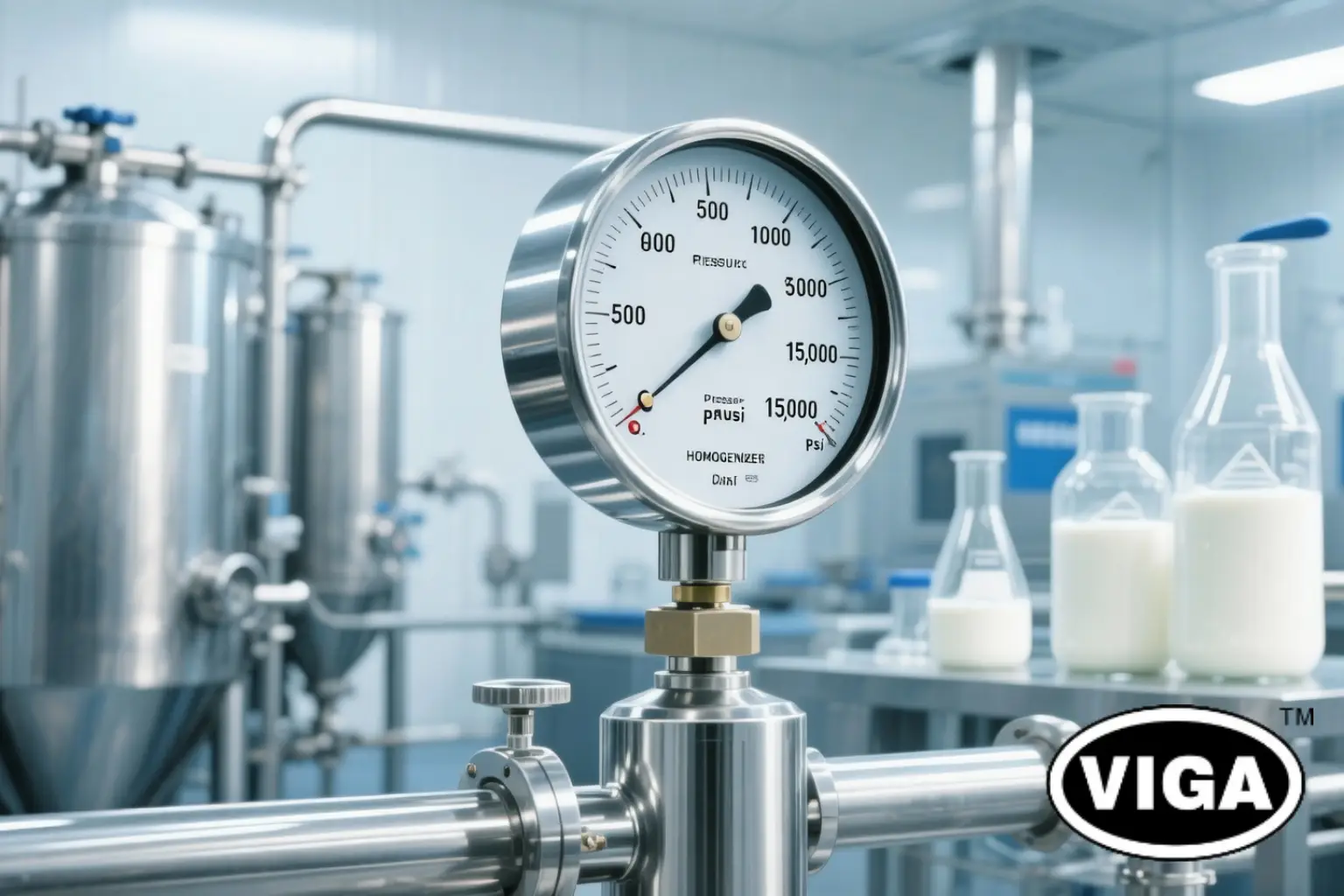
The Quest for Precision: Accuracy of Homogeniser Gauges
The Absolute dependability placed on a homogeniser is the Accuracy of Homogeniser Gauges. It is to be regarded that, regardless of extreme conditions of operation such as vibration or pressure, the homogeniser must never lose functionality.
In order to improve the reliability and precision of the gauge, the following enhancements are added:
Internal Dampening: Standard features on some Gauges are geared to control the violent movements and rapid oscillating cycles of the pointer which ensures that the pointer matches the system for a longer time.
The liquid filling: A plastic filling of the gauges, which is made of either glycerin or silicone oil, serves to guard the internal gear components against shocks, vibration, and gear wear by reducing internal pulsation.
Attribute of High Accuracy Class: For dependable and consistent control of processes, quality gauges are rated with an accuracy class for the full-scale value of 1% or 1.6%, which is guaranteed not to exceed these limits.
Regular calibration against a known pressure standard is equally important to flag the lapse of time and verify the accuracy of the gauge to ensure it still meets precision process requirements.
Outstanding compliance: the standard of homogeniser gauges
To ensure the safety, hygiene, and interoperability of homogeniser gauges, the devices are made in compliance with international standards of proven reputation.
3-A Sanitary Standards (e.g., 74-06): This revolves around the design of the gauge in a manner that facilitates cleaning and blocking inspection of the device, thus protecting against microbial contamination. This is a key standard, particularly in the US, for equipment in the dairy and food industry.
EN 837-1: This is a European standard that focuses on Bourdon tube pressure gauges by outlining the lay of metrology, dimensions, safety, and various testing.
FDA Compliance: For the diaphragm and the filling fluid that are in the gauge and are in contact with the product, the materials are controlled and approved by the FDA to be safe for food and pharmaceutical applications.
Following these Standards of Homogeniser Gauges provides the end-users with extra confidence that the instrument is safe, reliable, and applicable for its intended high-purity use.
Finding the Right Tool: Homogeniser Gauge Producers in India
India has become a center for the production of high-grade process instruments and even process-specialized homogeniser gauges. Many Homogeniser Gauge Manufacturers in India offer diverse and compliant products with global standards. Players like Adarsh Industries, CPI Technology, Topgrip Indus Instruments, and Shubh Instruments supply gauges manufactured to meet the stringent standards of the dairy and pharma industries.
When choosing a supplier it’s essential to consider the track record and the level of experience a supplier has, accompanied with a guarantee for the quality of the product, global standard compliance, and the provision of tailored solutions for particular process connections and pressure settings.
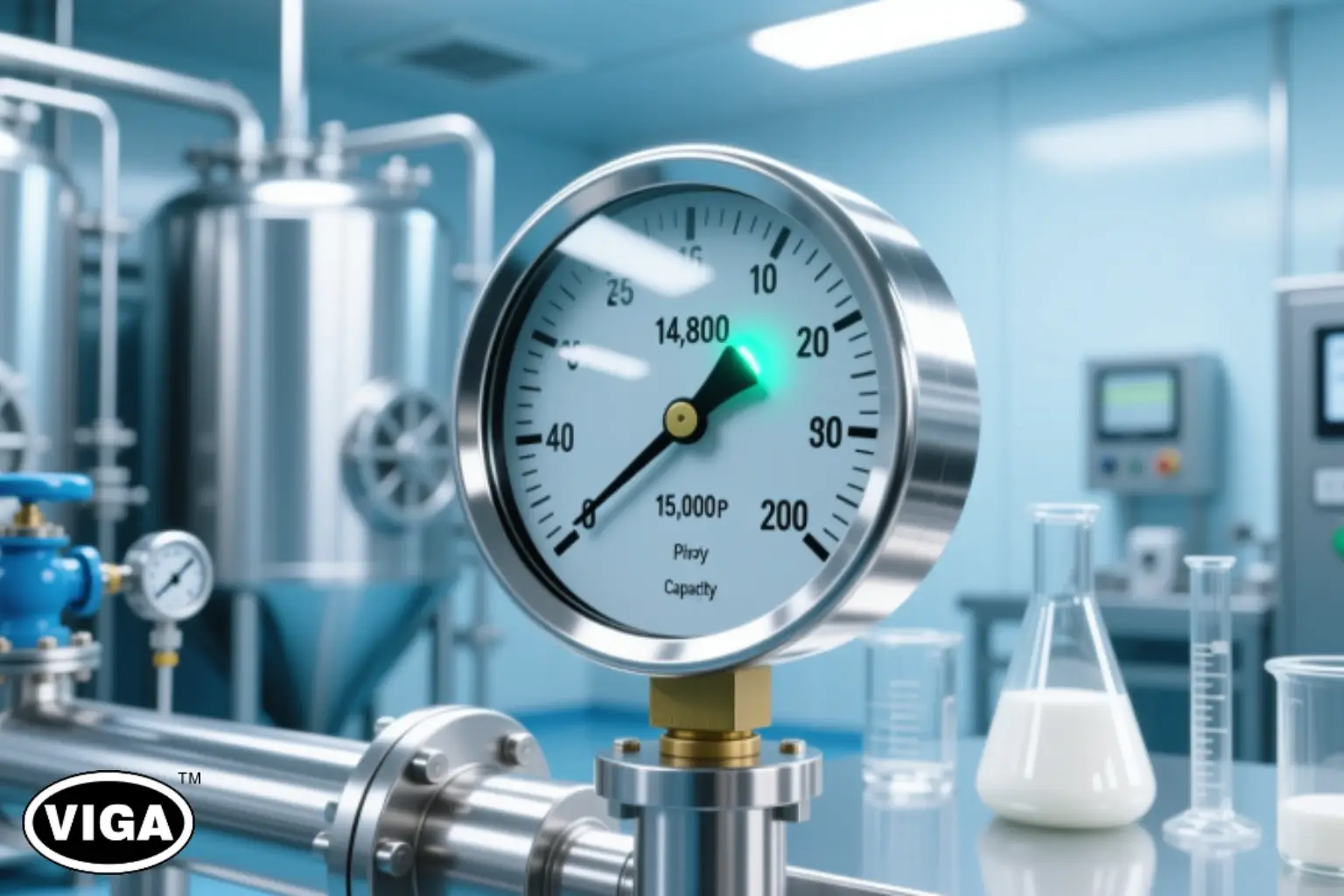
Conclusion: The focus is on Precision and Quality.
In the dairy and pharmaceutical industry, precision is fundamental and not optional. Success hinges on quality and safety. The homogeniser gauges are not merely measurement instruments, but also integral components of the economy. They facilitate the attainment of unparalleled quality in every drop of milk and every dosage of medicine. These devices, with their powerful and severely pressurized designs, also meticulous sanitary constructions, accomplish critical tasks in silence.
In such situations, the purchase of precision homogeniser gauges goes beyond mere utility, but becomes a statement of reliability. Speak to a reputable provider today to understand your high-pressure application, and measure your process with confidence.
Frequently Asked Questions (FAQs)
Q 1. What is the primary function of a homogeniser gauge?
A. Every homogeniser gauge is intended to provide a measurement of the intense pressure inside a homogeniser, and then display it on a screen. An operator can then automate the process of homogenization, and accomplish a level of precision that guarantees safety in machine operability and product output.2. What are the uses of glycerin as the filling in most homogeniser gauges?
Q2. Why are many homogeniser gauges filled with glycerin?
A. Glycerin filling serves two main functions; it acts as a protection from the vibrations and pressure pulsations coming from the homogenizer pump. It protects the gauge from internal damage and protects the sensitive parts of the gauge from being damaged. It also serves to much more accurately stabilizes the pointer allowing for much more ease in taking a reading.
Q 3. Can I install a standard pressure gauge on my homogeniser?
A. No, it is highly not recommended. Standard pressure gauges are made for gauges that are not set to extreme and continuous pressure pulsations that homogenizers are set to. They are also not set to the sanitary design needs for dairy and pharmaceuticals.
Q 4. How a Sanitary Diaphragm Gauge Works?
A. A diaphragm seal is a flexible membrane that separates the process fluid to the inside mechanism of the pressure gauge. The pressure from the fluid is transmitted through an FDA approved fill fluid to a pressure gauge. This fill fluid acts as a barrier from corrosive or viscous media and to primarily avoid contaminating the product with the gauge’s components.5. Typically, what are the pressure range values configured for gauges on high-pressure homogenizers?
Q 5. What are the typical pressure ranges for high-pressure homogeniser gauges?
A. The gauges are calibrated for extreme high pressures. Common ranges are configured from 0 – 1,000 PSI (approx. 70 bar) to 0 – 15,000 PSI (approx. 1,000 bar), while some gauges, calibrated for extreme high pressures, are capable of measuring even higher pressures ranging from 0 – 16,000 bar.
Q 6. Which factors should be prioritized most when selecting homogeniser gauges?
A. In selecting the right homogeniser gauges, the most critical aspects are: selecting the gauge with the most reliable accuracy class, selecting the wetted materials (such as SS316L) that are not reactive with the product, evaluating the sanitary compliance (such as 3-A) regulations that are relevant for the case, evaluating the range of pressures the gauge will be used for the intended application, the model that has been designed for high pulsation and vibration, and the over All System.


